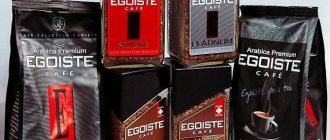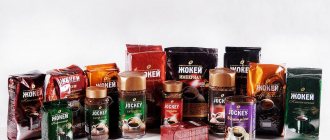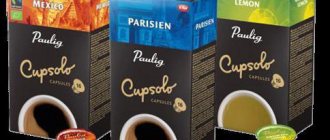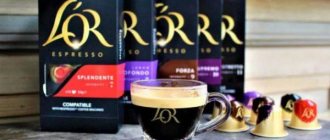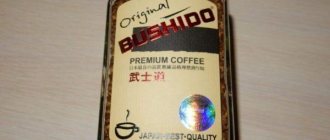Coffee Paulig President
The most popular variety is Paulig President coffee.
It is made from freshly roasted Arabica beans. The rich and intense aroma of the drink is obtained due to the fact that it contains a mixture of grains that have been roasted until light in color.
Ground coffee of this type can be found in packages from 75 to 500 grams, and the drink as beans is available only in packages of 250 grams.
You probably know that to make cappuccino coffee you need to thoroughly whisk the milk. To simplify this process, special coffee machines were invented, such as the Nespresso cappuccino machine.
Have you already tried mate green tea? This tea is from the country of Paraguay, which has a tonic property, more details in this article.
Paulig Classic
The taste of Paulig Classic coffee is also well received by consumers in the Baltic countries, Ukraine and Russia. It has an exquisite aroma as it is fried to medium.
This type of coffee is made from the Arabica variety. Consumers are offered a choice of Paulig Classic in ground form and grains.
Thanks to this, you can prepare coffee in different ways. Ground coffee is sold in packages from 100 to 500 grams, and beans in 250 gram packages.
Making coffee in a Turk remains the most enjoyable method of preparation for gourmets from Russia. Especially for them, the Paulig company produces all types of specially ground coffee that are suitable for this method of brewing.
But for those who don’t like or don’t know how to brew coffee, there is Mocha in-cup coffee. It can be brewed directly in a cup, which does not require much time.
Range
At the formation stage, the Paulig company traded green coffee beans. These were both single varieties and mixtures, which were produced under numbers for convenience. Further, grain coffee acquired names and a new “face”: it became roasted and even ground. Today, the brand’s assortment includes the following product names, which we list below.
President
The most popular line of the brand. It is high quality coffee collected on plantations in Costa Rica and Brazil. It has an unforgettable palette of aromas and tastes, which is why it has so many admirers. The mixture is based on only high-quality Arabica and a little Robusta for strength and bitterness. The photo shows the most famous ground product from the President line - Presidentti original. It is sold in packages of 75, 250 and 500 grams. Other representatives of the line include:
- PRESIDENTT GOLD beans and ground;
- PRESIDENTT BLACK ground and grain.
The black President Black is considered the strongest. Its degree of roasting is 4. Suitable for cooking in a Turk, coffee machine and cup.
Classic
This is a line of beans and ground coffee with classic taste and aroma properties. Roasting degree – 3. Paulig classic is sold in bags of 75, 250 and 500 grams. Suitable for cooking in a pot and cup, or can be prepared in a coffee machine.
Arabica
President Arabica is represented by a mixture of Arabica beans from Central and South America with a roasting degree of 3. The line contains ground Arabica beans Dark, which is dark roasted with a degree of 4. The products can be purchased both as grains and in ground form.
Espresso
This is a line of specially developed flavors for preparing real Italian espresso. The range includes:
- Paulig Espresso Originale ground and beans;
- Paulig Espresso Fortissimo ground and beans;
- Paulig Espresso Delicato ground and beans.
Coffee roasting degree from 3 to 4.
Other types
Brazil is a patented variety and is produced exclusively for Finland. It is an environmentally friendly product because its production does not cause any harm to the environment. The drink turns out quite rich with a pleasant tart aroma.
Kulta Katriina – undergoes a “gentle” roasting procedure, and the resulting coffee has a delicate, slightly sour taste and a “bright” aroma. The strength is medium, there is a slight bitterness. Fin Mokka – soft roast, 100% Arabica.
Hieno kahvi – in its mild taste, Kahvi is similar to Americano. The Finns themselves prefer to consume this variety without any additives in the form of cream, milk, etc. The drink has a very unusual, but at the same time incomparable aroma.
Robert Paulig can perfectly invigorate you in the morning or after a hard day at work, giving you strength and energy. It is preferred by most for its delicate aroma and pleasant aftertaste. There is also a second type, stronger, which is considered sharper, but nevertheless is in high demand among gourmets.
Black Label and Presidentti Gold are a luxury line made from elite coffee beans that have undergone strict quality control. Brewed coffee has a thick, strong taste and a slight bitterness. The aroma alone can awaken and lift your spirits on a cloudy day.
Parisien Coffee – which means “Parisian”; to get a special feeling, experts recommend consuming this variety exclusively with high-fat milk or cream.
Meira Saludo Coffee is a very common variety, consumed daily by a large number of consumers. The drink is aromatic, perfectly invigorating, and has a light chocolate flavor.
Mokka
One of the brand's most popular products. Presented with 100% Arabica coffee with a roasting degree of 4. This is a strong and aromatic drink in packages from 100 to 500 grams. Mocha tastes with chocolate and a slight bitterness, which most coffee connoisseurs really like.
Paulig Espresso Original
The Paulig Espresso Original coffee variety combines a mixture of dark roasted beans that have a very mild taste. It is very reminiscent of Italian coffee. This type of coffee is suitable not only for making espresso, but also for drinks based on it: Americano, lungo, ristretto, dopio...
Espresso Barista
An interesting variety of Paulig coffee is Espresso Barista.
It has a sour, sweet and bitter taste, harmoniously combined together. This taste is provided by the highest grade Arabica and Robusta.
Coffee is offered only in kilogram packages.
To brew Paraguayan mate tea I use special utensils: calabash and bombilla. Calabash is traditionally made from a special variety of melon.
One of the most tonic teas in the world, Pu-erh tea, is produced in China. Read more about how to choose pu-erh here.
Do you want to know how to lose weight simply by drinking special tea? Read the instructions for using Turboslim tea at the link: https://ahotcup.com/chai/drugie/turboslim-chajj-dlya-pohudenyja.html
Historical excursion
Both brands appeared at about the same time (60-70s of the 19th century) and very soon won everyone’s love. How did they do it?
Paulig
The founder of the company was Gustav Paulig, originally from the city of Lubeck, in Germany. Not wanting to follow in the footsteps of his gardener father, this young man moved to Helsinki in 1876. He opened a store there selling colonial goods, which he marked with the first letter of his last name - R. Very soon, such a mark began to be perceived by customers as a guarantee of excellent quality.
Gustav highly valued his reputation - only the best varieties of coffee and tea could be bought in his shop. In 1904, he established the production of roasted bean coffee (at that time, coffee beans were usually roasted by customers themselves). With the help of American technology, he raised roasting to an industrial level. The new product quickly found its connoisseur, because it saved time and was of high quality.
Today the company is owned by the descendants of that same Gustav Paulig. Paulig is a family business, but the scale of production of this brand is enormous, and the company's annual turnover amounts to millions of euros. This popularity is explained by a wide range of coffee products for every taste, as well as guaranteed quality.
One of the factories producing products under the Paulig brand is located in Russia. You can determine exactly where the coffee was made by looking at the special markings on the packaging.
Julius Meinl
Everyone is familiar with this icon - the silhouette of a boy’s head in a Turkish fez. It can be found on coffee and tea utensils, on the packaging of tea, coffee or sugar. This mark belongs to the Julius Meinl brand and is recognized throughout the world.
In 1862, the founder of the brand, merchant Julius Meinl, opened a coffee shop in the capital of Austria. This talented and enterprising man managed to say a new word in the coffee trade, and he was simply doomed to success. Julius Meinl was one of the first to start selling roasted and even ground coffee, relieving drink lovers of the hassle. In addition, the gourmet and experimenter began to create special, new coffee blends. Changing the proportions of Arabica and Robusta, combining beans from different countries, “playing” with the degree of roasting, he surprised customers with exquisite tastes.
The company's products were rapidly gaining popularity, and Meinl's shops and cafés opened throughout Europe. The logo of the family company, a boy in a fez, has become a sign of product quality and advertising for the establishments of this brand.
Today, Meinl’s descendants own several factories in Europe, and cafes and pastry shops bearing their logo can be found in every corner of the world. The company does not deal with instant drinks; its product range includes only coffee beans, ground and in pods.
Capsule coffee Paulig
Among the types of Paulig coffee there is a line of capsule drinks prepared in special coffee machines.
The convenience and speed of preparation of this drink has become indispensable for the modern coffee gourmet. Despite the simple preparation, the coffee retains its amazing aroma and unique taste.
Among capsule drinks you can find varieties of coffee such as black and cappuccino. You can also find thick cocoa and Paulig tea.
Due to the fact that Paulig always strives for consistently high quality of its products, it has proven itself well in the international market.
This world-famous coffee brand is one of the most popular in Europe, Russia and the Baltics. Its cost is quite high, but most gourmets are convinced that it is justified by the amazing taste, aroma and quality of the coffee.
Brand history
The young man came from Lübeck to the Grand Duchy of Finland, which at that time was part of the Russian Empire, in 1875. Gustav Paulig wanted to see the world and try his luck in search of an activity that would become his life's work. He initially settled in Tampere and got a job at Nokia, which at that time was a small pulp factory. And its owner, Frederic Idestam, had no idea about the prospects of his enterprise.
Gustave worked at the factory for a year, and then moved to Helsinki, deciding to open a shop of colonial goods. This was the name given to tea, coffee, spices - everything that was exported from the colonies. The young man decided to focus on coffee, and he was right. When Gustav met Bertha Bonhoff, fell in love and decided to marry in 1876, he was the owner of a successful business and a promising groom.
Brand founder Gustav Paulig and his wife Bertha
At first, the newlyweds lived in a small house on a plot of land that belonged to Bertha's father. And then, when the coffee bean roasting factory Paulig built was in full operation, he rented half a hectare of land near the bay and bought a villa located on that site. The new home was renovated and a cozy family home was created, in which three sons and 4 daughters of Gustav and Bertha were born and raised.
Known for his strict moral principles, Gustav Paulig tirelessly repeated to factory workers and salesmen: “Compromise on quality is unacceptable!” He taught the same to his children. When he died suddenly at the age of 56, his successor, his middle son Eduard, studied in Lübeck, and Bertha took over the company. She was the first female manager of a Finnish company.
For her expanding production, Bertha acquired a large plot of land and commissioned the design of a seven-story commercial building from the architect Woldemar Asperin, who was a friend of her late husband. In the meantime, while the project was being developed and construction was underway, she made an important deal with a Danish entrepreneur working in Helsinki who was experiencing financial difficulties: she bought from him 3 coffee shops and a popular coffee shop in the city center. After 2 years, the Paulig chain operated 25 coffee shops and a bakery, which, in addition to bread and rolls, baked baked goods specifically for coffee.
Construction of the new company building was completed in 1911. There was a place in it for a bean roasting workshop, the alluring aroma of which penetrated every corner, an office, a tasting room, and a warehouse for finished products. By that time, Eduard Paulig had returned after training, to whom Bertha handed over the reins. But before the new leader could take on the role, the First World War began. The import of coffee into Finland was stopped, and in order not to completely lose customers, Eduard Paulig began preparing a coffee drink from acorns, chicory and dandelion root.
The food crisis lasted until 1921: after the revolutionary coup in 1917, Finland declared secession from Russia, recovered from the military devastation, and formed a government. Only then did the Pauligs have the opportunity to import coffee beans, albeit at a very high price.
Back in 1919, Bertha reformatted the company, making it a joint-stock company, the shares of which were distributed among all family members. Eduard Paulig was elected executive director, who managed the company from 1919 to 1947. Bertha, at this time, was engaged in charity work, supported the poor, and even created a preschool institution with Aurora Karamzina, which still operates today - the Bertha Maria Hemmet kindergarten.
In the 50s, the board was headed by the grandson of the brand’s founder, Henrik. He had many ideas for the development of production, which gradually began to be implemented:
- moved the roasting and packaging shops to new premises;
- organized a service for interaction with consumers;
- published a collection of recipes;
- organized thematic meetings, the participants of which could get acquainted with the company’s products.
In 1980, Paulig established its own Coffee Institute to promote knowledge about the product, which became the basis of the family business. In the 90s, the company acquired another production site - a British bean roasting factory, and built factories in Tallinn and on the outskirts of Stockholm. In the period from 2006 to 2011, 3 more enterprises were built, one of them in Russia.
After 140 years, Paulig remains a family business, a market leader in the Baltics and Sweden. And the favorite brand of Finns, Swedes, Latvians and Danes.


